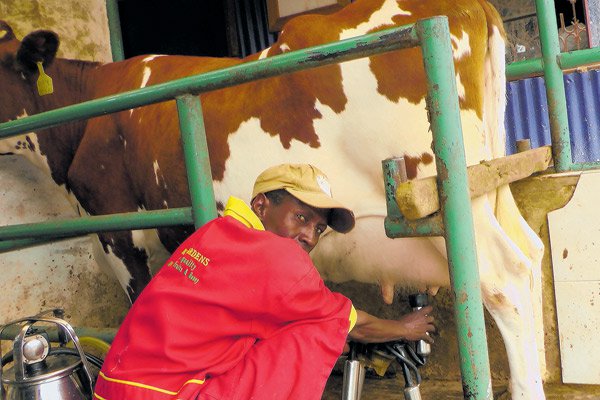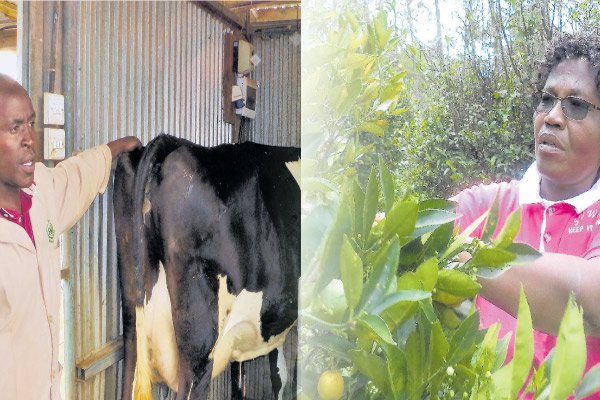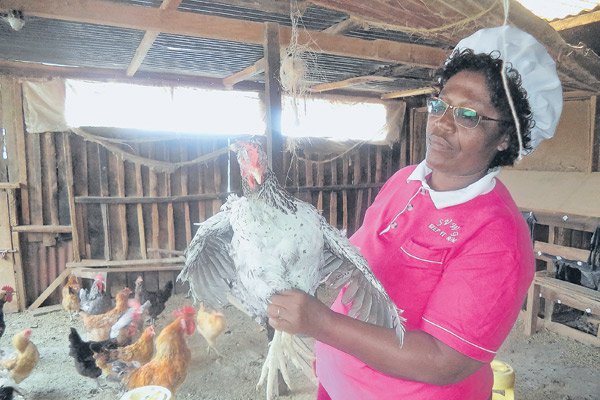Were it not for the beautiful blue metallic gate off the busy Makuyu–Sagana Road, nothing else would have suggested that the dusty road lead the vicinity of a popular dairy farm.
Kefa Farm sits on 1.5 acres and one can easily pass without noticing it as it lies in perfect harmony with the rest of the dry, somewhat abandoned farms.
Yet this farm is the source of 1,400 litres of milk daily. It has 64 zero–grazed cows each of which produces between 40 and 50 litres daily.
The farm located on a slope ideal for waste disposal also sells heifers and carries out embryo transfers.
It has gained reputation as a source of pedigree cows and a ground for training farmers on dairy management.
It receives about 100 visitors every month from Busia, Machakos, Meru, the Coast and across the border from Uganda, Tanzania, Burundi and Rwanda.
Situated in a semi–arid area of Makuyu in Murang’a County where temperatures average 21.7°C and receives 836mm of rainfall annually, the farm is showing new opportunities in the predominantly rain–fed agricultural zone.
Owner Dave Kimani credits its existence to the 2007/2008 post-election turmoil, which saw many displaced people settled in the region pushing up demand for milk.
“Then the farm was only half-an-acre with one cow and a worker. The steady rise in demand for milk made me devise ways to improve the farm,” says Kimani, noting he spent Sh90,000 on building a cowshed for five animals and bought two more Friesian cows at Sh40,000 each.
Since then, he has never looked back. “My herd grew to 82 in 2014, but I had to reduce the number to 64 due to limited space and scarcity of feeds,” he says.
The farm sank its own borehole and expanded by purchasing one more adjacent acre and another four acres where heifers are bred. He also leases other farms to grow fodder.
Kimani improved his skills in animal care, health and farm management by attending agricultural trainings, visiting other farms, researching and came up with a programme to develop the skills of his 10 workers.
In addition to the 64 cows, the farm has over 30 calves at any one time aged between a day and two months, hundreds of pigs, chicken and ducks.
Milk, the farm’s main product, goes for Sh45 per litre. Customers who mainly comprise of hotels and institutions bank the money in the farm’s account and present slips to collect milk in a model that has enhanced efficiency and accountability, with Kimani earning up to Sh60,000 daily from milk sales.
The farm has four departments each headed by different persons.
Agribusiness Farms in Kenya: ADOPTION OF EMBRYO TRANSFER TECHNOLOGY
These are stores, sales, production and milking. Each head has a full mandate to hire casuals and make other decisions.
They report daily to Kimani by filing updates to a central computer system where all managers can access the information.
For example, the store head can caution imminent shortage of feeds or the milking head can send alert on a certain animal noted for declining production.

This triggers simultaneous actions like investigations to establish the causes, purchase of drugs if illness is reported or isolation of the animal. Updates on action taken are filed.
The animals are hosted on half-acre, with the cowsheds divided into sections that include steamers, milking, maternity and calves of between zero and three months and another for winnowers aged six months.
The winnowers are moved out of the main farm to another in the neighbourhood where buyers easily access them. At the far end is an isolation section for the sick animals.
Each animal occupies its own shed shielded from rains, extreme cold and direct wind. It does not lie on the cement floor as it is provided with a mat covering the entire floor.
“Every animal has a name, card and file to record production. Before milking, the animal is called by name, then the udders are massaged patiently for a long time and the animal’s immediate behaviour taken note of. It must show signs of cooling its nerves and readiness to produce milk,” says Kimani, noting milking is done twice a day.
Workers are always on stand-by to clean the cowsheds by removing dung and ensuring the units are completely dry each time to keep diseases at bay.
The animals’ feeds include napier grass, sweet potato vines and lucerne. Instead of digging pits to make silage, the farm uses giant plastic containers.
“The making of our own feeds helps us to cut costs of feeding by 60 per cent. We formulate the feeds depending on the animals, for instance, heifer feeds are different from those of bulls,” says Kimani adding that besides silage, the animals are also given concentrates and salt.
The farm’s milestone in the recent past is the adoption of embryo transfer technology to breed its animals.
It involves two cows, one the donor and the other the recipient. They undergo synchronisation to ensure that each is ready. The donor is inseminated and after seven days the embryo is ready for transfer.
Agribusiness Farms in Kenya: DEMYSTIFYING THE MYTH
The process is done on the farm by experts from the University of Nairobi and sometimes South Africa.
“Embryo transfer helps the farmer to benefit from a shortened period of attaining a pedigree animal. Ordinarily it takes at least five years for the farmer to get pedigree as the cow goes through the pool, foundation, appendix and pedigree stages,” says Kimani.
Embryo transfer has historically been associated with big farms but Kimani is demystifying this myth. He notes that even smaller farmers can undertake the technology which reduces the cost of the getting pedigree animal to Sh50,000 from Sh300,000 and shortens the period to about a year from five.
However, the process is not all rosy as sometimes the transfer fails.
“Sometimes it is caused by failure to conceive other times the embryo may degenerate.”
Kefa Farm also keeps bulls for slaughter, with the number currently standing at 25 animals of between one and three years.
They take about one year to mature weighing between 800 and 1,000kg. One carcass yields between 650 to 700kg of meat each going for Sh320.
Kimani, now a self-made dairy expert, receives over 10 calls a day from farmers across the country including from Kisii, Kiambu, Meru and Kericho.
He also makes follow up on his callers and those who visit his farm allowing them to consult him regularly.
He organises customised training for various clients at a fee of Sh500 per head per visit. Kefa Farm has a training partnership with the Strathmore University and the Cooperative University where agribusiness students visit for lessons.
“Kenyans no longer need to mystify dairy farming by going to Israel for lessons. Israel is here at Kefa Farm,” he says, acknowledging that most farmers lack information.
In fives years, he hopes he would be able to open a milk processing plant and increase his dairy herd to 150 cows Alex Njenga, an agricultural extension officer in Kiambu, says adequate training is crucial for the success of any farmer.
However, he notes that most successful dairy farmers close their gates on smallholders seeking information and skills.
“There is need to structure farmers training programmes to co-opt farms that understand the benefits of overall agricultural development to the country.”
Agribusiness Farms in Kenya: Animal gives birth to Sh10m business
On one part of the well-kept homestead in Kirika, Nyandarua County, sits a heap of animal manure and on the other are cowsheds.
Next to the animal sheds are chicken houses made of iron sheets and timber and pigsties.
And as one ventures deeper inside the compound, the spectacle that is Rose Kagondu’s two-acre home, which is also her farm, becomes clear.
The former secondary school secretary keeps chickens, pigs, goats, two donkeys and 20 dairy cows in a venture she estimates is currently worth over Sh10 million.
“I have been farming for 13 years now. I quit my job in 2004 to fully concentrate on farming after investing about Sh40,000, the bulk which went to buying a cow. I can’t compare my achievements as a farmer with the 15 years I worked as a secretary,” says Rose, 56, noting her homestead sits on half-acre and she uses the rest for farming.
Of her 20 Friesian cows, four are lactating, seven are calves, three are in-calf and six heifers.
She milks 100 litres per day and sells raw milk at between Sh40 and Sh60.
“My high milker offers me 45 litres while the other between 15 and 20 litres,” she says, adding she sells a litre of yoghurt at Sh120.
To make yoghurt, she starts by adding four table spoons of sugar to a litre of fresh milk and then boiling it.
Appropriate food colours and flavours are added before boiling the milk once again. The milk is then cooled to 450C. This can be measured using a thermometer which is available in many agrovet shops at Sh100.
She makes silage from napier grass, dry maize stalks and hay that she grows from leased farms.
“We do the first feeding after the morning milking session, which is between 5:30am to 7am. Apart from the early morning milking, the rest of the milking is done at different hours depending on individual cow production capacity. Some animals are milked at 1pm and others at 3pm, where thereafter each cow gets its second share of feeding.”
Since she could not afford pedigree animals, Rose who started with a single dairy cow has been improving her stock through artificial insemination with the hope of ending up with pedigree animals.
Agribusiness Farms in Kenya: INVEST IN WATER PANS
She is now in the third stage, one more remaining to achieve her desired breed.
On her pig farm, she keeps five mature animals and 25 piglets.
“Pigs are my latest addition. I would like to grow the brood first befoe I start selling them,” she says.
On the crops farm, she plants a variety of vegetables, including spinach, potatoes, oranges and tree tomatoes.
“The crops sit on various portions of an acre I grow them,” she says, noting the tree tomatoes earn her Sh8,000 every two weeks while oranges an average of Sh20,000, with the produce being sold in markets in the region.
Being a dry area, she has heavily invested in water harvesting tanks.
But still, a prolonged dry spell early this year saw her water pan dry up, resulting into the withering of her vegetables.
Her chicken brood comprises of 3,000 layers and 500 Kienyeji birds.
From the layers she supplies eggs to Nairobi markets at Sh280 to Sh300 where she has a weekly order to deliver on Mondays.
“My aim is to replace the layers slowly with Kienyeji birds because the latter offer more returns and are hardy. Currently I sell locally their eggs at Sh15 each.”
From the proceeds of her farming ventures, Rose has bought a pickup truck for farm transport and some ten acres, four of them in Meru where she plans to venture into tissue culture banana farming.
“I recently bought the vehicle but was previously using donkeys to transport animal feeds. They are cheap because they do not require fuel. I started with a wheelbarrow, then to a bicycle, then the donkeys and now a pickup,” she quipped.
Agribusiness Farms in Kenya: DEDICATION AND RIGHT TRAINING
Her other farms host fodder and maize, with the farmer harvesting an average of 150 90kg bags of the cereal in a year.
Kagondu says she choose mixed farming because she did not want to put her eggs in one basket.
“With this kind of farming, each activity complements the other, since I get manure from cows and chicken and use it to plant the various crops including maize. I don’t use inorganic fertilisers on my farm at all, which has helped me cut production costs,” says Kagondu who has two workers and attends farmers’ field days and other trainings for lessons.
“Farming is a lucrative business, no woman should introduce herself as a house wife so long as they have a small plot where they can practice farming,” the mother of four offers.
Nyandarua agricultural officer Samuel Maina says with dedication and the right training, a farmer can start small and build an empire in about a decade.
“An acre is good for producing enough feeds for one cow. With proper management and husbandry, the cow will deliver a calf each year, translating to 10 cows in 10 years,” he explains, adding it calls for proper planning, as from the calves, a farmer can own about 25 cows in the same period.
Raising healthy animals has a lot to do with managing a cow’s stress, an area many farmers score poorly.
A cow also needs enough rest and should not be moved from point to another unnecessarily as this will stress it and interfere with its milk production system.
Animals should be left to relax after milking.
Clean the cowsheds twice a day to make sure teats are not infected with mastitis or other diseases
There is no point of having a clean cow that is being handled by a dirty worker.
Agribusiness Farms in Kenya Source; seeds of gold










Hi, I would like to visit the farm. Kindly assist with contacts